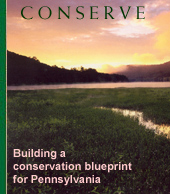| |
North Central Forests and West
Branch Susquehanna Basin
The largest and most contiguous stretches of forestlands are within the High Allegheny Plateau of north central Pennsylvania. Here the highest elevations of the plateau are typically above 2,000 feet. This region represents the headwaters of the West Branch of the Susquehanna River. Although some streams are degraded, largely by coal mining, several sub-watersheds are of high quality and currently are refuges for aquatic life.
West Branch Susquehanna River Watershed
The West Branch Susquehanna River watershed is located in north central Pennsylvania. It drains approximately 4.5 million acres, which is just less than 7,000 square miles. The watershed contains more than 1.4 million acres of state forest land, more than 250,000 acres of state game lands, and more than 29,000 acres of state park land.
Forests dominate the land cover of the watershed, with very little area being used for agricultural purposes. Nearly all of Pennsylvania’s elk herd resides within the watershed.
Despite the wild nature of the watershed, its overall potential is limited by water quality degradation, which impairs aquatic life throughout most of the system. The largest culprit, abandoned mine drainage, is responsible for polluting 57 percent of the watershed. Of the watershed’s pollutants, 94 percent can be attributed to the legacy of coal mining in the region.
Tamarack Swamp
In the early 1990s WPC purchased more than 9,400 acres in Clinton County to become an addition to Sproul State Forest. Part of this area, known as Tamarack Swamp, is within Sproul State Forest and contains one of the most unique natural habitats in Western Pennsylvania.
The site is named for the unusual presence of tamarack (Larix laricina), the only native deciduous (annually leaf-shedding) conifer tree in Pennsylvania. Although commonly referred to as a swamp, the main section is a non-glacial bog dominated by boreal conifers typically found in high latitude northern forests. When North America’s last glacial period ended, most other boreal habitats retreated northward, while this unique wetland remained intact and today serves as one of the few examples of a black spruce, balsam fir and tamarack wetland in north central Pennsylvania.
This conservation site is reported as having the highest importance in the Clinton County Natural Heritage Inventory, due to the unique wetland communities and rare species of plants and insects. The swamp forms the headwaters of Drury Run, an Exceptional Value, high-gradient clearwater stream. At this special place three plants classified as "rare" and two that are "endangered" have been recorded, including Hooker's orchid and small-floating manna-grass. In addition, there are five records for animals of special concern, all of which are dragonflies.
Tamarack Swamp has been designated an Important Bird Area by Audubon Pennsylvania. Some of the bird species found at this site include golden-winged warbler, northern waterthrush, black-billed cuckoo, broad-winged hawk, alder flycatcher and great crested flycatcher.
Threats to this landscape include development on the uplands, oil and gas extraction, introduction of exotic species and unsustainable forest management. The conservation strategies for this area include maintaining the site as a natural area, buffering the wetland with forest, acquiring critical habitat that harbors species of special concern and conserving the upper Drury Run watershed.
|
|
